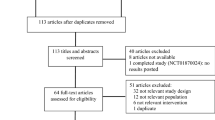Abstract
Objective
To evaluate the safety and efficacy of three benzodiazepine drugs: Lorazepam, Midazolam and Diazepam, when given parenterally in the control of acute seizure.
Methods
One hundred and twenty children of either sex in the age group 6 month to 14 years brought convulsing to the pediatric emergency services, were enrolled in the study. These were randomised to three equal groups of 40 patients each; Group A—received diazepam, Group B—received midazolam, Group C—received lorazepam. End of seizure episode (clinically) was defined as cessation of visible epileptic phenomenon or return of purposeful response to external stimuli within 15 min of drug administration. A stopwatch was used to measure various time intervals accurately. The patient’s vitals were monitored and recorded in a predesigned performa. The primary outcome was the time to seizure cessation and secondary outcome was the side effects of the drugs. Data obtained was analysed statistically using student’s t-test and chi-square test.
Results
Mean duration to clinical seizure cessation was comparable among the three groups. For diazepam group it was 84.94 ± 38.56 s, for midazolam group it was 92.69 ± 25.97 s, for lorazepam group it was 91.12 ± 23.58 s. Number of patients with any abnormality in seizure cessation were significantly higher in diazepam group [11/40 (27.5%)] when compared to the midazolam [4/40 (10%)] and lorazepam group [2/40 (5%)]. Number of patients requiring 2nd dose to control seizures was significantly higher [4/40 (10%)] in diazepam group when compared to lorazepam group [0/40 (0%)] but diazepam and midazolam and midazolam and lorazepam were comparable in this aspect.All the three drugs were comparable in terms of side effects except excessive somnolence which was significantly higher in diazepam group.
Conclusions
All the three groups were comparable in terms of time to clinical seizure cessation, seizure recurrence and uncontrolled seizures after drug administration. However, number of patients requiring second dose to control seizures were significantly higher in diazepam group when compared to lorazepam group. Excessive somnolence and sedation occurred more frequently with diazepam.

Similar content being viewed by others
References
Working group on status epilepticus. Treatment of Convulsive Status Epilepticus: Recommendation of the epilepsy foundation of America’s working group on status epilepticus. JAMA. 1993;270:854–9.
Maytal J, Shinnar S, Moshe SL, Alvarez LA. Low morbidity and mortality of status epilepticus in children. Pediatrics. 1989;83:323–31.
Celesia GG. Prognosis in convulsive status epilepticus. Adv Neurol. 1983;34:55–8.
Haafiz A, Kissoon N. Status epilepticus: current concepts. Pediatr Emerg Care. 1999;15:119–29.
Hanhan UA, Fiallos MR, Orlowski JP. Status epilepticus. Pediatr Clin N Am. 2001;48:683–94.
Wolf SM, Ochoa JG, Conway Jr EE. Seizure management in pediatric patients for the nineties. Pediatr Ann. 1998;27:653–64.
Friedman MJ, Sharieff GQ. Seizures in children. Pediatr Clin N Am. 2006;53:257–77.
Qureshi A, Wassmer E, Davies P, Berry K, Whitehouse WP. Comparative audit of intravenous lorazepam and diazepam in the emergency treatment of convulsive status epilepticus in children. Seizure. 2002;11:141–4.
Alldredge BK, Gelb AM, Isaacs SM, et al. A comparison of lorazepam, diazepam, and placebo for the treatment of out of hospital status epilepticus. N Engl J Med. 2001;345:631–7.
Aicardi J, Chevrie JJ. Convulsive status epilepticus in infants and children. A study of 239 cases. Epilepsia. 1970;11:187–97.
Guerrini R. Epilepsy in children. Lancet. 2006;367:499–524.
Riss J, Cloyd J, Gates J, Collin S. Benzodiazepines in epilepsy: Pharmacology and pharmokinetics. Acta Neurol Scand. 2008;118:69–86.
Yoshikawa H, Yamazaki S, Abe T, Oda Y. Midazolam as a first-line agent for status epilepticus in children. Brain Dev. 2000;22:239–42.
Shah I, Deshmukh CT. Intramuscular midazolam vs. intravenous diazepam for acute seizures. Indian J Pediatr. 2005;72:667–70.
Appleton R, Sweeney A, Choonara I, Robson J, Molyneux E. Lorazepam versus diazepam in the acute treatment of epileptic seizures and status epilepticus. Dev Med Child Neurol. 1995;37:682–8.
Cock HR, Schapira AH. A comparison of lorazepam and diazepam as initial therapy in convulsive status epilepticus. QJM. 2002;95:225–31.
Leppik IE, Derivan AT, Homan RW, Walker J, Ramsay RE, Patrick B. Double-blind study of lorazepam and diazepam in status epilepticus. JAMA. 1983;249:1452–4.
Mitchell WG, Crawford TO. Lorazepam is the treatment of choice for status epilepticus. J Epilepsy. 1990;3:7–10.
Rivera R, Segnini M, Baltodano A, Perez V. Midazolam in the treatment of status epilepticus in children. Critical Care Med. 1993;21:991–4.
Conflict of Interest
None.
Role of Funding Source
None.
Author information
Authors and Affiliations
Corresponding author
Rights and permissions
About this article
Cite this article
Gathwala, G., Goel, M., Singh, J. et al. Intravenous Diazepam, Midazolam and Lorazepam in Acute Seizure Control. Indian J Pediatr 79, 327–332 (2012). https://doi.org/10.1007/s12098-011-0505-y
Received:
Accepted:
Published:
Issue Date:
DOI: https://doi.org/10.1007/s12098-011-0505-y



